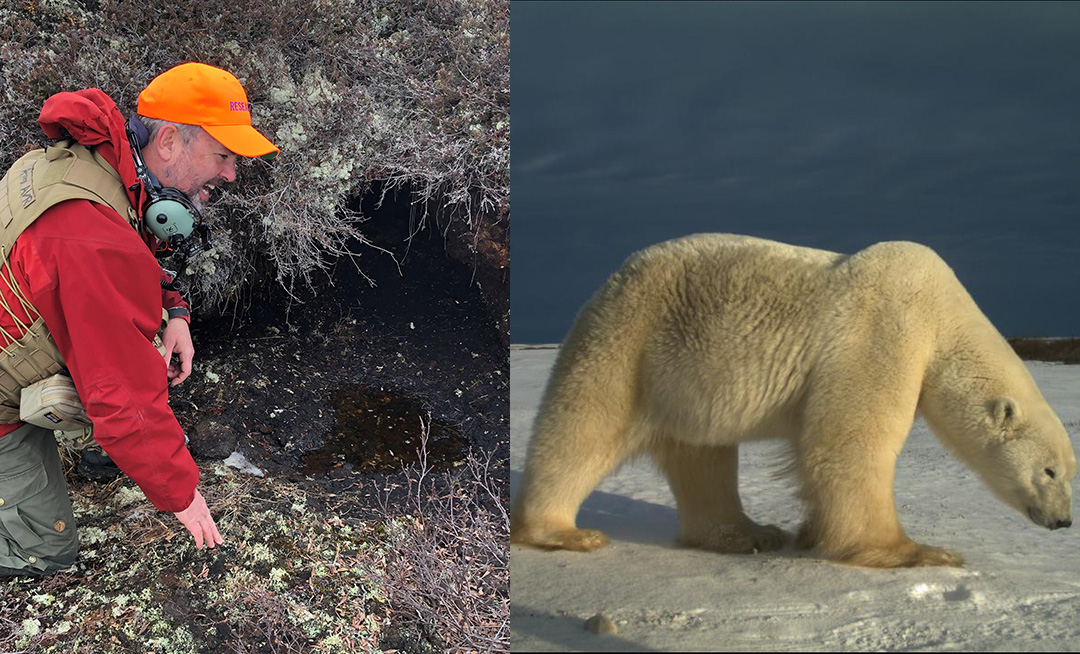
USask researchers discover swath of previously undocumented polar bear dens
Scientists from the University of Saskatchewan (USask) have identified several polar bear dens while performing grizzly bear research.
By Matt Olson, Research Profile and ImpactDr. Doug Clark (PhD) has crawled into many polar bear dens as a graduate student and in a former job as a park warden.
So many, in fact, that when Clark and his group of researchers identified a large number of previously undocumented dens north of Churchill, Man., – more than 100 kilometres further north than any other documented polar bear dens – he knew they belonged to polar bears.
“We knew these were polar bear dens for a couple of reasons. One, they were in peat deposits ... but more to the point, we found polar bear hair,” Clark said.
USask has a long tradition of excellence in polar bear research, and Clark said finding these new dens was positive for both researchers and for polar bear populations. The discovery was recently published in a paper in Arctic Science.
“To me, it’s cause for excitement,” he said. “There is a lot of legitimate concern about this specific population of polar bears in western Hudson Bay.”
The discovery of the dens was completely by chance. Clark, an associate professor in USask’s School of Environment and Sustainability (SENS) and the acting executive director of the school, was in northern Manitoba as part of a research project tracking grizzly bear expansion in the area.
He said they identified what appeared to be a series of polar bear dens during a helicopter flight, which they were able to then confirm along the Caribou River and Seal River.
“Polar bears have a bigger bag of tricks than we usually give them credit for,” he said. “Even though figuring out what’s going on is complicated, seeing polar bears do something like this, whether we’ve overlooked it or whether it’s new or not, they’re doing something that we – the conventional scientific narrative – did not expect.”
Polar bears in this population’s main denning area – 120 km south of these newly-described dens – will travel an average of 50 to 80 kilometres inland to build dens in permafrost-underlain river and lake banks. As Clark puts it, pregnant polar bears and female polar bears with cubs will travel so far at least in part to avoid males, because large males will eat cubs.
While these dens may have been new to the researchers, they weren’t new to the community. Clark said upon their return many Churchill residents confirmed they’d seen the tracks of polar bears with cubs in spring, heading out to the sea ice from inland along those rivers. Thanks to this insight from community members, the researchers believe that some of these dens were maternity dens where females would go to give birth. Other dens may simply have been used temporarily for keeping cool during the area’s brief but hot summers.
Clark said it’s not yet clear how long the newly identified dens had been there for. Some dens further south have been dated as older than 250 years.
“This is important regardless of whether the dens are new or not. If they’re new then something’s changing, but if they’re not, then there may be a chunk of this population of bears that have been overlooked in studies so far,” Clark said.
Many of these “new” dens are located within an Indigenous Protected Area monitored by the Seal River Watershed Alliance (SRWA). Stephanie Thorassie, the executive director of the SRWA, said the connections between researchers and communities play an important role.
“We are excited by the information the science community is finding. At the end of the day, these partnerships with our communities help to reaffirm the knowledge our land users have been talking about, and this feels good to us,” Thorassie said. “We look forward to continuing these partnerships pairing science with our knowledge to get the best understandings of our traditional lands and home."
Clark said the next steps will be to work with colleagues in the alliance to determine the best approach for figuring out how many of these dens are used, how regularly, and by which bears.
“What I’m hoping is that our work to figure out what’s going on and better understand polar bear denning up in that area can be done with community guidance and leadership,” he said. “I’m really proud of the set of collaborations and relationships that have gone into this research.”
Together, we will undertake the research the world needs. We invite you to join by supporting critical research at USask.

